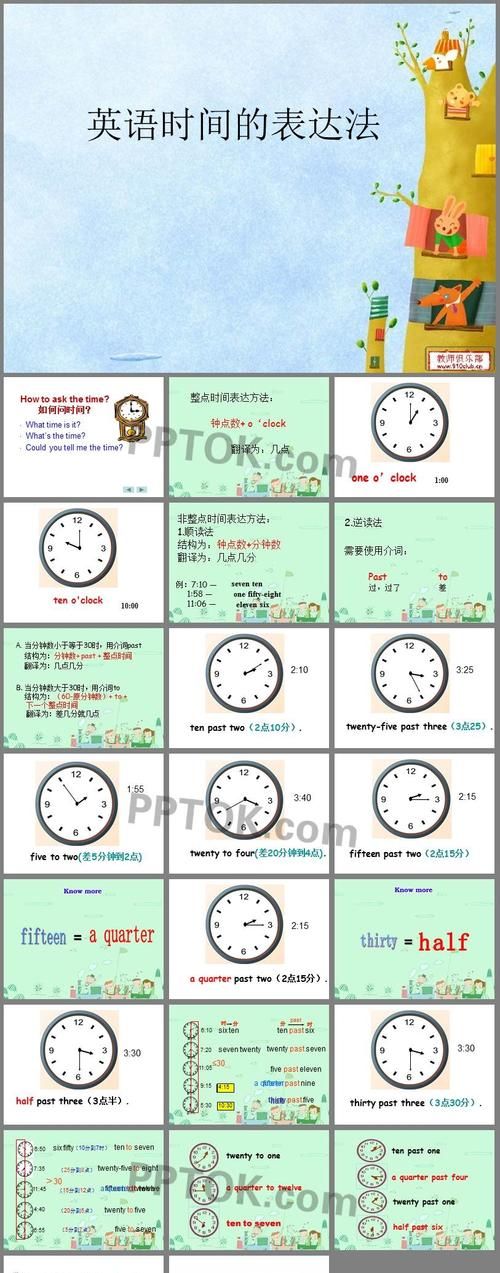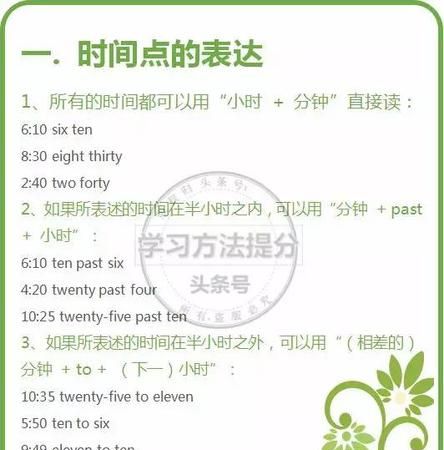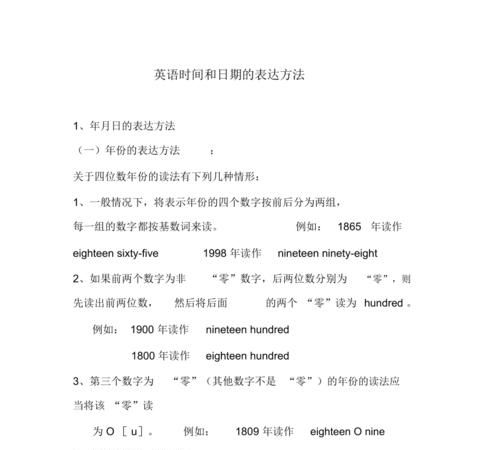本文目录
英语语法基数词和序数词思维导图
英语语法顺口溜:基数词变序数词
基数词变序数词(之一)
基变序,有规律,
词尾字母th。①
八减t,九减e,
f要把ve替。②ty把y变成i,
记住th前有个e。③
①按:指first、second、third。
②按:指eight去掉t,nine去掉e,five和twelve去掉ve加上f。
⑦按:指twenty→twentieth等。
基数词变序数词(之二)
第一、二、三要全变,①
其余“th”加后边,⑧“th”里有例外,
你需格外记明白:
八减t,九减e,②
字母f代ve,④ty变tie。⑥
①one——first,two——second,three——third。
②four-fourth,seven-seventh,hundred-hundredth。
③eight——eighth,nine—ninth。
④five—fifth,twelve—twelfth。
⑤twenty—twentieth,sixty——sixtieth。
直接引语间接引语的记忆口诀、定语从句记忆口诀、被动语态的口诀
人称变更怎么办? “一主①、二宾②、三不变”③
若是自引自的话, 听者不变称不变。
注:①“一主”指在直接引语中的第一人称变为间接引语时,要和主句中的主语在人称上保持一致。如:
He sad,“I am forty,”→He said that he was forty.
②“二宾”指直接引语中的第二人称变为间接引语时,要和主句中的间接宾语保持人称一致。如:
He said,“Are you coming tomorrow?”→He asked me if I wascoming the next day.
③“三不变”指直接引语中的第三人称变为间接引语时,人称不变。如:
He said,“Is she an English teacher?”→He asked if she was an English teacher.
另外注意直接引语为复数,引述者主语为单数,间接引语主语相应变复数。如:
He said,“Are you interested in English?”→He asked me/us if Iwas/we were interested in English.
一般现、过用be done,be有人称、时、数变。
完成时态have done,被动将been加中间。
一般将来shall (will) do,被动变do为be done。
将来进行无被动,shall (will) be doing,
现在完成进行同,have (has) been doing。
现、过进行be doing, 被动be加being done。
情、助、有、是妥安排,一律随新主语变。
否定助后加not,疑问一助置主前。
主语恰是疑问词,直陈语序主在前。
一般情助加be done,双宾多将间宾变。
复合宾语宾变主,宾补、主补相应变。
英语语法顺口溜:冠词、定冠词和不定冠词口诀和用法
一、定冠词的用法口诀
特指双熟悉,上文已提及;
世上独无二,序数最高级;
某些专有名,习语及乐器。
二、不用冠词用法口诀
下列情况应免冠,代词限定名词前;
专有名词不可数,学科球类三餐饭;
复数名词表泛指,两节星期月份前;
颜色语种和国名,称呼习语及头衔。
一、定冠词和不定冠词的用法详解
1.定冠词the,在以辅音音素开头的词前读作[], 在以元音音素开头的词前读作[], 强调时读作。
例:the table]那张桌子
the animal那只动物
2.定冠词the,基本含义是“这个,那个”,表示特指。
例: the flower 那朵花 the E-mail 那个电子邮件
3.不定冠词a和an,基本含义是“一、一个”,表示泛指。
例:a flower 一朵花 an E-mail 一个电子邮件
二、a和an的区别
a用在辅音音素前,包括以前元音[j]、[w]开首的词前,注意,这里讲的辅音音素指的是发音,不是指辅音字母。
an用在元音音素前(不是元音字母),
例:a hotel [一家旅馆
a knife 一把小刀
a useful tool 一件有用的工具
a university 一所大学
a European country一个欧洲国家
a one-eyed man一个一目失明的`人
an hour ] 一小时
an ant 一只蚂蚁
an honour 一种荣誉
an honest boy 一个诚实的男孩
an umbrella 一把伞
an onion一个洋葱
an eye 一只眼睛
an ear [一只耳朵
an English book [ 一本英语书
an egg 一只鸡蛋
an ap 一个苹果
an island 一座岛
an uncle一位叔叔
an old man 一位老人
三、不定冠词
1 表示“一,一个”,用在单数可数名词前
例:There is a picture on the wall. 墙上有一幅图画。
He has an apple in his hand. 他手里拿着一个苹果。
提示:
a. a (an) 虽表示“一个”,但不强调数量,而是强调类别;one则强调数量。
例:I bought a computer. 我买了一台电脑。(不是收音机和电视机)
I bought one computer. 我买了一台电脑。 (不是两台)
Would you like an ice cream? 来一客冰淇淋好吗?(不是别的食物)
She gave one ice cream to them each. 她给他们每人一客冰淇淋。(不是两客)
b. 表示数量对比时,要用one, 不用a(an)。
比:我有一支红铅笔,但是他有三支。
I have a red pencil, but she has three. (误)
I have one red pencil, but she has three. (正)
我只需要一美元,但他给了我两美元。
I only want a dollar, but he has given me two. (误)
I only want one dollar, but he has given me two. (正)
2 表示一类人或物,指同类中的任何一个,a或an不必翻译
例 Even a child can answer this question. 就是小孩子也能回答这个问题。
An elephant is stronger than a horse. 大象比马力气大。
A teacher must be strict with his students. 教师必须对学生严格要求。
3 第一次提到某人或某物
第一次提到某人或某物时,用不定冠词a或an,起介绍作用。
例: A girl wants to see you. 一位姑娘要见你。
On a cold evening a stranger came to my house. 在一个寒冷的晚上,一个陌生人来到我的住处。
4 表示身份、职业
不定冠词用于单数名词前表示身份、职业,尤其用在作表语或补足语的名词前。
例:She is a high school teacher. Her name is Li Fang. 她是一位中学教师,名叫李芳。
The Whites wanted their daughter to be a musician. 怀特夫妇想要他们的女儿成为音乐家。
提示:
表示某个职位在某一时期内只有一人担任,或表示某人的头衔,则不用冠词。
例:He is captain of the team. 他是球队队长。
Zhang Fei, monitor of their class, is good at English. 张飞是他们的班长,英语很棒。
5 用于专有名词前,表示不认识某人
例:A Zhang called you just now. 一位姓张的刚才给你打电话。
A Mr. Smith wanted to see you. 有位史密斯先生想要见你。
6 不定冠词用在表示数量、长度、时间等的计数单位的名词前,表示“每一”
例:We have three meals a day. 我们每天吃三顿饭。
They met each other once a month. 他们每月会面一次。
The car moved 100 miles an hour. 这辆小汽车以每小时100英里的速度行驶。
The envelopes are one yuan a dozen. 信封一打是一元钱。
Amily goes to see her grandmother twice a week. 爱米莉每周去看奶奶两次。
小升初英语必考考点:小学英语形容词比较级顺口溜
小学英语形容词比较级顺口溜
比较级是形容词,一好一坏要记牢,
good更好是better, bad更坏是worse
结尾有e只加r,nice变成nicer;
双写目前有三个,bigger, fatter 和hotter
其余全部加er。
小升初英语必考考点:疑问句顺口溜
疑问句顺口溜
反义疑问真好变,前后肯否相反地。
有情要用情加主,有be要用be加主。
若是无情又无be,要用do主来代替。
Let's go特殊记,Shall we 提前要牢记。
肯定英汉翻译同,否定英汉翻译异。
100句少儿英语口语让孩子英语顺溜溜
1. Hello! (How do you do?) 你好!
2. How are you?-I’m fine. Thank you. and you? 你好吗?我很好。谢谢,你呢?
3. Good morning / afternoon/evening/night. 早上好/下午好/晚上好/晚安。
4. Excuse me。(sorry. I’m sorry) 打搅一下(对不起/不好意思)
5. Thank you! 谢谢你!
6. You are welcome. 不用谢。
7. How are you today? 今天还好吗?
8. Nice to meet you. 见到你很高兴。
9. What’s your name? 你叫什么名子啊?
10. My name is×××. 我叫×××。
11. What can I do for you? 我能为你做点什么?
12. What’s wrong with you? (What’sthe matter?)你怎么了?(出什么事了?)
13. It’s time for class. 该上课了。
14. Come in please. 请进。
15. Let’s get ready for class! 让我们准备上课吧!
16. Line up please! 排队!
17. Attention please! 立正!
18. At ease. 稍息。
19. Turn life/right! 向左/右转!
20. One bye one please.no pushing. 一个一个来。不要挤。
21. Let’s go back to the classroom. 让我们回教室去。
22. It’time for (breakfast lunch supper/dinner) 该吃早餐了/该吃午餐了/该吃晚餐了
23. Please eat up. Take your time. 把它吃完。慢慢吃。
24. Would you like some rice!来点米饭吧!
25. Help yourself. 请吃,别客气。
26. Please have some fish/vegetables. 吃点鱼/蔬菜吧。
27. Do you want anymore? 还要吗?
28. Anything to drink? 喝点啥?
29. I’d like to drink some milk! 我想喝点年奶!
30. Today we are going to learn some new worlds.今天我们将学习一些新单词。
31. Who wants to try? 谁来试试?
32. Let me try! 我来试试!
33. It’s your turn. 轮到你了。
34. Don’t be afraid/shy! 不要害怕/不要害羞!
35. Try your best! 尽力做/尽力试。
36. Do you understand? 明白了吗?
37. Stand up/sit down.please. 请站起来/请坐下。
38. Listen to me carefully. pease. 请仔细地听我说。
39. Look at me ,please. 请看着我。
40. Watch carefully. 看仔细。
41. What are you going to do tonight? 今晚干啥去?
42. I’m going to Disney’s English Club. 我要去迪士尼英语俱乐部。
43. I’m going to learn Disney’s Magic English. 我去学迪士尼神奇英语。
44. What’s on tonight? 今晚有什么节目?
45. Let’s watch TV. 我们看电视吧!
46. We are going to the Pople’s Prk. 我们要去人民公园。
47. Be quiet.please. 请安静。
48. Stop talking!(Do’t talk.) 别讲话。
49. Don’t worry about it. 不要为这担心。
50. No problem. 没问题。
51. Clap your hands. 鼓撑拍手。
52. Class is over.(Time is up.) 下课了!(时间到了)
53. See you next time.Bye bye! 下次见,再见。
54. Well done! 干得好!
55. You are so smart! 你真聪明!
56. How clever you are! 你真是太聪明了!
57. Let’s have a rest.(take a break) 我们休息一下。
58. It’s time to go to bed. 该睡觉了。
59. It’s time to get up.(Wake up.please。) 该起床了(醒醒)
60. Wash your face/hands/foot. 洗脸/手/脚。
61. Comb your hair. 梳头。
62. Brush your teeth. 刷牙。
63. Come on.Let’s play together. 过来,我们一起玩。
64. Let’s play a game. 我们来玩个游戏。
65. You are getting better and better. 你越来越棒了。
66. You’er making progress everyday. 你每天都在进步。
67. You’re always the best. 你总是最好的。
68. You speak English very well. 你英语说的非常好。
69. Do you like English? (Ilike English very much) 你喜欢英语吗?(我太喜欢英语了)
70. I’mpleased with your spoken English. 你的口语真令我满意。
71. Be brave,please. 请勇敢一点。
72. Have a nice weekend! 周未愉快!
73. Happy birthday to you. (Happy New Year to you) 生日快乐!(新年快乐)
74. Put on your clothes. 穿衣服。
75. Take off your clothes/shoes. 脱衣服/鞋子。
76. Pardon! (I beg your pardon) 什么!请你再说一次。
77. May I speak to×××.Please. ×××在吗?
78. Who is on the line? 你是谁啊?(电话用语)
79. This is OSA. 我是OSA。(电话用语)
80. Welcome to Shiyan. 欢迎来到十堰。
81. Do you like shiyan? 你喜欢十堰吗?
82. People in Shiyan are proud of Wudang Mountain. 十堰的人以武当山为豪。
83. Are you free this afternoon? 今天下午你有空吗?
84. I’m inviting you to Mcdonald’s. 我请你去麦当劳。
85. At what time shall I come? 我什么时候可以过来。
86. Is six o’clock ok with you? 六点可以吗?
87. This way .please! 这边走!
88. Have a good time。(Enjoy yourself) 玩得愉快!
89. The same to you! 你也一样!
90. You are learning fast. 你学得很快。
91. Keep on trying. 不断努力。
92. Put up your hands.please。(Raise your hands,please/hands up) 请举手。
93. Hands down. 放下手。
94. Be careful. (look out) 小心!
95. How are you feeling today? 你今天感觉怎么样?
96. Fine.thanks.and you? 很好,谢谢,你呢?
97. Hope to see you again! 希望能再见到你。
98. Drink some water/tea,please. 请喝水/茶。
99. Which one will you choose? 你要哪个?
100. Goodbye. See you tomorrow/late/next week! 再见。明天见。
少儿英语语法顺口溜:时刻表达记忆口诀
英语时刻表达法记忆口诀:
时刻表达法作用大,衣食住行离不开它。
整点时把点钟数打,时分俱全不好表达。
请记下列几种方法:先时后分莫给弄差。
若要说明几点过几分,可把past和after来抓。
前分后时不能搞差,要说几点几分差, to前分后时来表达。
用英语表达时刻主要有以下两种方法:
直接表示法(先时后分)如:
9 : 25 读作: nine twenty-five
12 : 30 读作: twelve thirty ; twelve-thirty
添加介词表示法(先分后时)如:
( 1 )表示“几点过几分”(在 30 分钟之内),用介词 past ,其结构是“分钟 +past+ 钟点”。如:
5 : 20 读作: twenty past five
11 : 05 读作: five past eleven
( 2 )表示“几点差几分”(相差在 30 分钟之内),用介词 to ,其结构是“分钟 +to+ 下一个钟点”。如:
2 : 50 读作: ten to three
10 : 58 读作: two to eleven
6 : 37 读作: twenty-three to seven
另外需要注意的还有:
( 1 )表示“几点整”,可以用数字直接表示,也可以加上 o'clock 。如:
1 : 00 读作: one o'clock
20 : 00 读作: twenty o'clock
( 2 )表示“几点半”,用 half 。如:
4 : 30 读作: half past four
( 3 )表示“ 15 分钟”,常用 a quarter 。如:
10 : 15 读作: a quarter past ten
2 : 45 读作: a quarter to three
( 4 )表示“在某一时刻”,应该用介词 at 。如:
at five-five 在 5 点 5 分
at three o'clock 在 3 点整
( 5 )对时刻提问时,疑问词一般用 what time 。如:
— What time is it now ?现在几点钟?
— It's twelve fifteen. 12 点 15 分。

英语里面时间的表达方法
英语中时间的表达方法主要有直接法和借用介词法等。
(1)直接法
上午八点eight AM (a.m.)
下午九点nine PM (p.m.)
六点六分six six 六点三十二six thirty two
八点正eight o'clock
(2)借用介词法
八点四十五a quarter to nine
七点零五分five past seven
七点五十四six to eight
六点半half past six
(3)表示正点的用法
十一点正at 11 o'clock sharp
at 11 o'clock on the hour
at 11 o'clock on the strike
正午12点at noon
午夜12点at midnight
(注:12点22分可读作:twelve twenty-two:twenty-two past twelve(英式说法);twenty-two after twelve(美式说法)
1点15可读作:one fifteen; a quarter past one(英式说法):a quarter after one(美英说法)
8点50分可读作:eight fifty;ten to nine(英式说法);ten before nine(美式说法)
1点40分可读作:one forty;twenty to two(英式说法);twenty before two(美式说法)
“提前半小时”可用:half an hour early;thirty minutes early; early by half an hour;half an hour ahead of time;half an hour ahead of schedule等来表示。)更多知识点可关注下北京新东方小学全科教育的小学英语课程。

小学英语主要学哪些知识点
1现在进行时
表示正在发生的事情或进行的动作,常与now,listen,look等词连用,结构是主语+be动词(am, is, are)+动词ing.
如:It is raining now.
外面正在下雨
It is six o’clock now.
现在6点了
My parents are reading newspapers in the sitting room.
我父母正在客厅看报纸
Look! The children are having a running race now.
看!孩子们正在赛跑
问句将be动词移前,否定句在be动词后+not.
2一般现在时
表示经常反复发生的事情或动作,常与often, usually, sometimes, always, every day(week year…) on Sundays等词连用。
结构是主语+动词原形;当主语为第三人称单数即he,she, it, Tom, my mother, the boy等词时,动词后加s或es.
如:We have an English lesson every day.
我们每天都要上英语课
Do the boys run faster than the girls? Yes, they do.
男孩比女孩跑的快吗?是的
问句借助于do, does否定句借助于don’t, doesn’t,后面动词一定要还原。
3一般过去时
表示发生在过去的事情或存在的状态,常与just now; a moment ago; … ago; yesterday; last ( week; month; year; Monday; weekend); this morning等词连用。
结构是主语+be动词的过去式(was; were)或主语+动词的过去式。
注意:be动词与动词过去式不可同时使用。
如:My earphones were on the ground just now.
我的耳机刚刚还在呢。
Where were you last week? I was at a camp.
你上个星期去哪了?我去野营了
What did you do yesterday? I visited a farm
你昨天去干嘛了?我去参观农场了。
问句有be动词将be动词移前,没有be动词借助于did,后面动词还原;
否定句有be动词在后面加not,没有借助于didn't后面动词还原。
4一般将来时
表示将要打算发生的事情或动作,常与tomorrow, next week(year; Tuesday…), this week( weekend ;evening; afternoon;…)today等词连用。结构是主语+be(am, is, are) going to + 动原或主语+will +动原。
如:What are you going to do tomorrow? I am going to have a txt.
你明天要去干嘛?我要去野餐。
The childre are going to have a sports meeting next week.
孩子们下个星期将参加运动会。
Tom will/is going to see a play with his father this evening.
Tom今晚将和父母去看演出。
问句将be动词或will移前;否定句在be动词或will后加not.
5情态动词
can; can’t; should; shouldn’t; must; may后一定加动词原形。
如:The girl can’t swim, but she can skate.
女孩不会游泳,但是会滑冰
Don’t talk in class, you should listen to the teacher carefully.
不要再课上说话,你应该认真听老师讲。
6祈使句
肯定祈使句以动词原形开头;否定祈使句以don’t加动词原形开头。
如:Open the box for me ,please.
请为我打开盒子。
Liu Tao! Please get up earlier tomorrow.
刘涛,明天请早点起床!
Don’t walk on the grass!
不要在草地上走!
Helen! Don’t climb the tree,please.
海伦!不要爬树。
7go的用法
去干嘛用go +动词ing
如: go swimming; go fishing;
go skating;
go camping;
go running;
go skiing;
go rowing…
8比较
than 前用比较级;as…as之间用原级。
如:My mother is two years younger than my father.
我妈比我爸年轻两岁。
Liu Tao jumps as far as Ben.
刘涛跳得和本一样远。
9喜欢做某事
用like +动词ing或like+ to + 动原。
如:Su Yang likes growing flowers.
苏阳喜欢种花。
The children like to play with lanterns at Spring Festival.
孩子们喜欢在春节去玩花灯。
10想要做某事
用 would like +to+动原或want + to +动原。
例:I’d like to visit the History Museum.=I want to visit the History Museum
11some
用于肯定句中,在否定句和问句中改为any,但当表示委婉语气时仍用
如:Can I have some writing paper? Would you like some orange juice?
12代词
人称代词主格做主语用一般放在句首或动词前,主格分别是 I you he she it we you they。
宾格做宾语用,一般放在动词或介词后
如:Open them for me. Let us …, join me等。
宾格分别是me you him her it us you them。
形容词性物主代词放在名词前,不能单独使用,分别是my your his her its our your their
名词性物主代词相当于形物加名词,它只能单独使用后面不好加名词,分别是mine yours his hers its ours yours theirs。
13介词
介词后要么不加动词,加动词只能加动词ing形式
如:be good at running;
do well in jumping;
14时间介词
季节前,月份前用介词in
如:in summer;in March
具体的哪一天如星期几,几月几日用介词on
如:on Saturday; on the second of April; on Wednesday morning
在几点钟前用介词at
如:at a quarter to four;
只在上下午晚上用in
如:in the morning/ afternoon/ evening;
但在夜间用at night。
另:季节,月份和星期前不好加the.
15名词复数构成的方法
有规则的有:
(1)直接在名词后加s
如orange—oranges; photo—photos;
(2) 以x, s, sh, ch 结尾的加es
如:box—boxes; glass—glasses; waitress—waitresses; watch—watches;peach--peaches
(3) 以辅音字母加y结尾的改y为i加es
如:study—studies;library—libraries; hobby—hobbies; family—families;
(4)以f, fe结尾的改f, fe 为v+es如:knife—knives; thief—thieves(注:以o结尾的我们学过的只有mango加es, mango—mangoes其余加s,)
不规则的有:
man—men; woman—women; people—people; child—children
16动词第三人称单数的构成
(1)直接在动词后加s
如:run—runs; dance—dances
(2)以s,sh,ch,o结尾的加es
如:do—does;go—goes;wash—washes;catch—catches
(3)以辅音字母加y结尾的改y为i加es
如:study—studies; carry—carries;
17现在分词的构成
(1)直接在动词后加ing
如:sing—singing; ski—skiing;
(2)双写词尾加ing
如:swim—swimming; jog—jogging;run—running;
(3)以不发音的e结尾的去e加ing
如:ride—riding; dance—dancing; make—making;
18规则动词过去式的构成
(1)直接在动词后加ed
如:clean—cleaned; milk—milked; play—played;
(2)以e结尾的直接加d
如:dance—danced; taste—tasted;
(3) 以辅音字母加y结尾的改y为i加ed
如:study—studied;carry—carried;
(4)双写词尾加ed
如:stop—stopped; jog—jogged;
不规则的有:am,is—was; are—were; do,does—did; have,has—had; go—went; meet—met; sit—sat; see—saw; get—got; tell—told; run—ran; come—came; steal—stole; read—read;
19形容词副词比较级的构成
规则的:
(1)直接在形容词或副词后加er
如;small—smaller; low—lower;
(2)以e结尾的加r
如:late—larer;
(3)双写词尾加er
如:big—bigger; thin—thinner; fat—fatter;
(4) 以辅音字母加y结尾的改y为i加er
如:heavy—heavier; early—earlier;
不规则的有:
good, well—better(最高级为best); many, much--- more(最高级为most); far---farther;
20rain与snow的用法
(1)作为名词意思是雨水和雪是不可数名词
如:There is a lot of rain there in spring. 那儿的春天有很多雨水。
(2) 作为动词意思是下雨和下雪,有四种形式分别是:
动词原形rain, snow;
第三人称单数rains ,snows;
现在分词raining;snowing
过去式rained;snowed;
如:①Look! It is raining now. 瞧!天正在下雨。
②It often rains in Nantong in summer.南通夏天经常下雨。
③ It rained yesterday.昨天下了雨。
④It is going to rain tomorrow. 明天要下雨。
(3)形容词为rainy 和snowy 意思是有雨的和有雪的
如:It is often rainy here in spring.这儿的春天经常是有雨的。
If it is rainy tomorrow, I’ll stay at home.如果明天是有雨的,我将呆在家里。
21比较级
注意只有同类事物才可进行比较。
如:My eyes are bigger than hers.Your school bag is heavier than mine. My computer is nicer than Nancy’s. My brother is stronger than me.
22have, has
表示某人有(has用于第三人称单数);There is/ are;
There was/ were 表示某地存在有
注意There be 句型的就近原则
单数或不可数用there is /was;
复数用there are/ were.
23本身就是复数的词
眼镜glasses; 耳机earphones; 鞋shoes;裤子trousers等词本身是复数。
如:My glasses were on the chair just now.
但如果表示这双,这副,一双的时候用单数
如:There is a pair of chopsticks on the plate. This pair of earphones is for you.
24五个元音字母分别是Aa, Ee, Ii, Oo, Uu;
25一个的用法
a用于辅音前不是辅音字母前;an 用于元音前不是元音字母前。
如:There is an ’s’, a ‘t’, a ‘u’, a ‘d’ ,an ‘e’, an ‘n’,and a ‘t’ in the word ‘student’.
26时间表示法
有两种:
(1)直接读时钟和分钟。
如6:10读成 six ten; 7:30读成seven thirty; 8:45读成eight forty-five;
(2)用to与past表示。
在半小时包括半小时以内用几分past几点
如:6:10读成ten past six; 7:30读成half past seven;
过了半小时用下一个钟点差几分
如7:45读成a quarter to eight; 9:50读成ten to ten;
27基数词变序数词的方法
基变序有规律,结尾加上th; 一二三特殊例,结尾字母t、d(即first, second, third);
八去t, 九去e, ve要用f替(即eigh—eighth; nine—ninth; five-- fifth ;twelve—twelfth);
ty改y为ie后加th别忘记(即整十数如twenty—twentieth;forty—fortieth);
几十几十位为基个位为序(如第二十一为twenty-first)。
另外强调序数词前一定要加the。
28日期的表示法
用the+序数词+ of +月
如:三月三日 the third of March;
12月25日 the 25th of December.
29both 表示两者都
如:My parents are both teachers.
all表示三者以上都
如:The students are all very excited.
30节日的表示法
有day的节日前用on.
没有day的节日前用at,
如:at Christmas; on Christmas Day; at New Year; on New Year’s Day.
31激动兴奋的
excited表示激动的,兴奋地主语是人;
exciting表示令人激动的,令人兴奋的主语是事情
如:The running race is very exciting, so all the students are very excited.
赛跑非常令人激动,因此所有的学生都很激动。
32比较
两者比较用比较级,三者以上比较用最高级
如:Who runs faster, the boy or the girl? The boy does
谁跑得更快,男孩还是女孩?男孩。
Which season do you like best? I like autumn best.
你最喜欢哪个季节?我最喜欢秋天。
Which season do you like better, summer or winter? I like winter better.
你更喜欢哪个季节,夏天还是冬天?我更喜欢冬天。
33动词还原的用法
前面用了do, does did, don’t, doesn’t didn’t后面动词要还原。
如:Did she watch TV last night?
Helen doesn’t like taking photos.
34到了
到达用get to
但注意到家,到这儿,到那儿不可以加to
如:get home; get here; get there,
另外go home; come here; go there也一样。
35长着和穿着
长着什么用with
如:the girl with big eyes 大眼睛的女孩;
穿着什么用in
如:the man in black穿黑衣服的男人
或:the woman in the white skirt 穿白色短裙的妇女
36让某人做某事
用let sb后加动词原形
如:Let’s water the flowers together.
是该做…的时候了用It’s time for+名词或It’s time to +动原。
帮助某人做某事是help sb with sth
如:帮我学英语是 help me with my English
37树上
外来的东西在树上用in the tree
如:the bird in the tree;
树上长的用on the tree
如:the apples on the tree
38运动和乐器
球类之前不加the;
乐器之前必须加the
如:play the piano; play football
39一周中的第一天是Sunday; 一年中的第一个月是January
40get后加比较级表示变得更怎么样 。如:get stronger; get longer

小学英语语法速记口诀
从普特英语听力网的语法栏目搬过来的内容 希望对你有用
一、冠词基本用法
【速记口诀】
名词是秃子,常要戴帽子,
可数名词单,须用a或an,
辅音前用a, an在元音前,
若为特指时,则须用定冠,
复数不可数,泛指the不见,
碰到代词时,冠词均不现。
【妙语诠释】冠词是中考必考的语法知识之一,也是中考考查的主要对象。以上口诀包括的意思有:①名词在一般情况下不单用,常常要和冠词连用;②表示不确指的可数名词单数前要用不定冠词a或an,确指时要用定冠词the;③如复数名词表示泛指,名词前有this,these,my,some等时就不用冠词。
二、名词单数变复数规则
【速记口诀】
单数变复数,规则要记住,
一般加s,特殊有几处:
/s/结尾,es不离后,
末尾字母o,大多加s,
两人有两菜,es不离口,
词尾f、fe,s前有v和e;
没有规则词,必须单独记。
【妙语诠释】 ①大部分单数可数名词变为复数要加s,但如果单词以/t?蘩/、/?蘩/、/s/发音结尾(也就是单词如果以ch,sh,s,x等结尾),则一般加es;②以o结尾的单词除了两人(negro,hero)两菜(tomato,potato)加es外,其余一般加s;③以f或fe结尾的单词一般是把f,fe变为ve再加s;④英语中还有些单词没有规则,需要特殊记忆,如child—children,mouse—mice,deer—deer,sheep—sheep,Chinese—Chinese,ox—oxen,man—men,woman—women,foot—feet,tooth—teeth。
三、名词所有格用法
【速记口诀】
名词所有格,表物是“谁的”,
若为生命词,加“’s”即可行,
词尾有s,仅把逗号择;
并列名词后,各自和共有,
前者分别加,后者最后加;
若为无生命词,of所有格,
前后须倒置,此是硬规则。
【妙语诠释】 ①有生命的名词所有格一般加s,但如果名词以s结尾,则只加“’”;②并列名词所有格表示各自所有时,分别加“’s”,如果是共有,则只在最后名词加“’s”;③如果是无生命的名词则用of表示所有格,这里需要注意它们的顺序与汉语不同,A of B要翻译为B的A。
四、接不定式作宾语的动词
【速记口诀】
三个希望两答应,两个要求莫拒绝;
设法学会做决定,不要假装在选择。
【妙语诠释】
三个希望两答应:hope,wish,want,agree,promise
两个要求莫拒绝:demand,ask,refuse
设法学会做决定:manage,learn,decide
不要假装在选择:petend,choose
五、接动名词作宾语的动词
【速记口诀】
Mrs. P Black missed a beef bag. (P·布莱克夫人丢了一个牛肉袋。)
【妙语诠释】 该句话中每个字母代表了一个动词或短语,这些动词要求后面跟动名词作宾语。这些动词分别是:
M=mind, r=risk, s=succeed in,P=practice,B=be busy, l=look forward to,a=admit,c=can’t help, k=keep on, m=miss,i=insist on,s=suggest,s=stop,e=enjoy,d=delay,
a=avoid,b=be worth,a=advise,g=give up。
六、不定式作宾语补足语时省to的动词
【速记口诀】
一感,二听,三让,四看,半帮助
【妙语诠释】 一感:feel;二听:hear,listen to;三让:make,let,have;四看:see,notice,watch,ob-serve;半帮助:help。
七、形容词和副词比较等级用法
【速记口诀】
1. 比较级与最高级:两者比较than相连,三者比较the在前。
2.同级比较:同级比较用原形,as…as永不离;as…as加not,只言两者是同一,若是not so…as,后强前弱不看齐。
【妙语诠释】 ①比较级通常和than连用,而最高级通常跟有定冠词the;②同级比较一般用as…as表示“与…一样”,这时谁强谁弱不能比较出来,而not so…as则表示后者比前者强,翻译为“不如……”。
八、反意疑问句用法
【速记口诀】
反意问句三要点,前后谓语正相反;
短句not如出现,必须缩写是习惯;
最后一点应注意,短句主语代词填。
【妙语诠释】 ①反意疑问句的构成应该是“肯定的陈述句+否定的疑问”或“否定的陈述句+肯定的疑问”;②在短句中not必须与do,will,can等组成缩写形式;③在简短问句中,疑问句的主语必须是代词,而不能用名词形式。
九、感叹句用法
【速记口诀】
感叹句,并不难,what、how放句前;
强调名词用what,其余用how很简单。
【妙语诠释】 由what引导的感叹句一般修饰名词,而how引导的感叹句一般修饰形容词、副词或句子。
十、宾语从句用法
【速记口诀】
宾语从句须注意,几点事项应牢记。
一是关键引导词,不同句子词相异。
陈述句子用that;一般疑问是否(if,whether)替;特殊问句更好办,引导还用疑问词。
二是时态常变化,主句不同从句异。主句若为现在时,从句时态应看意;主句若为过去时,从句时态向前移。
三是语序要记清,从句永保陈述序。
【妙语诠释】宾语从句应注意三点:①引导词,陈述句一般由that引导,这时的that可以省略;一般疑问句则由if或whe-ther引导;而特殊疑问句则由特殊疑问词引导。②时态,主句是现在时态,从句可用所需要的任何时态;但如果主句是过去时态,从句时态所表示时间一般往前移一个时间段。③语序,宾语从句永远要用陈述句顺序。

以上就是关于小学英语时间表达法口诀 ,英语语法基数词和序数词思维导图的全部内容,以及小学英语时间表达法口诀 的相关内容,希望能够帮到您。

